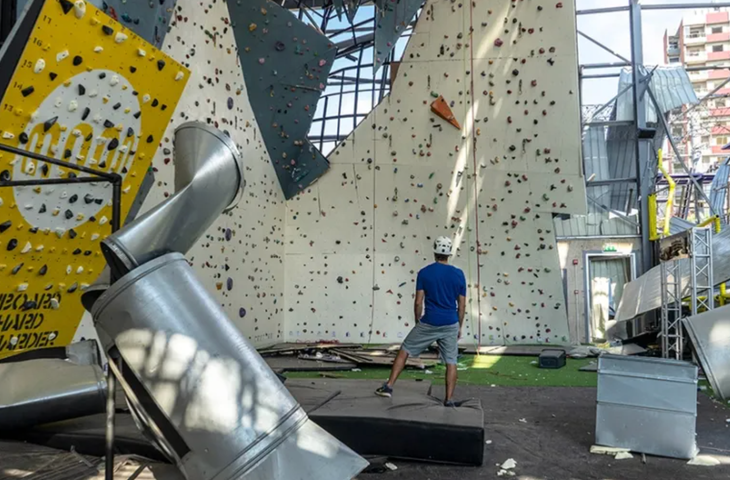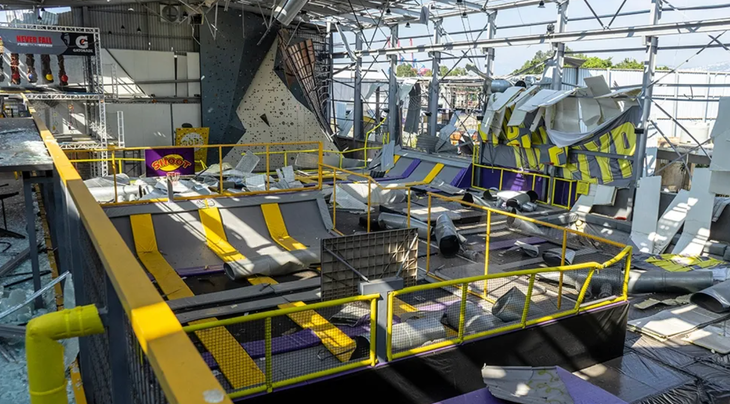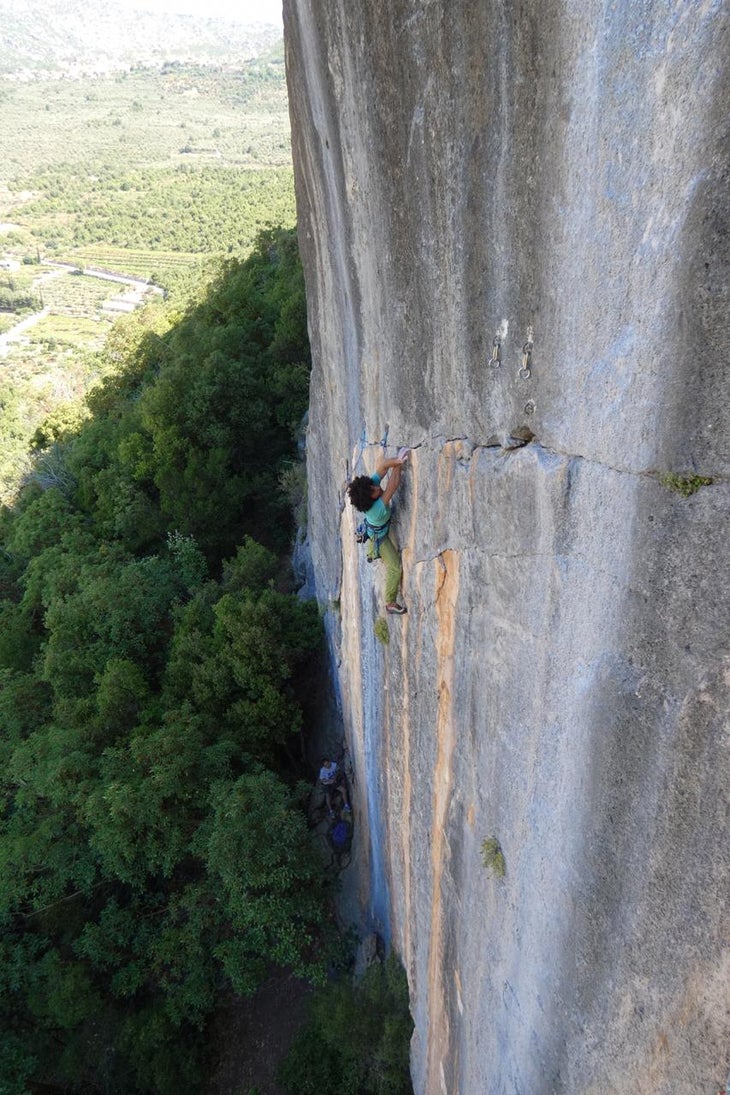In War-torn Lebanon, Climbers are Building Tomorrow’s Utopia
After a devastating explosion, Beirut residents are turning to climbing for hope. And with the ongoing development of classic lines on incredible rock, there’s a lot to be excited about.
Heading out the door? Read this article on the new Outside+ app available now on iOS devices for members! Download the app.
On August 4, 2020, around 6 p.m., a warehouse in Beirut, Lebanon started billowing smoke. The warehouse contained nearly 3,000 tons of ammonium nitrate,15 tons of fireworks, dry tinder, and large containers of kerosene and hydrochloric acid. It’s not exactly clear what started the fire in the first place, though according to a New York Times investigation, nearby welding activity seems a likely cause. Whatever the initial spark, it landed in exactly the wrong place.
The blaze set off a burst of fireworks, one of which ignited the ammonium nitrate. The combustion was catastrophic. A blinding torrent of flames shot skyward, hurling a deadly shockwave across the port—and into the neighborhood of Karantina. Flyp Climbing, a place that many of the city’s climbers considered their second home, was obliterated.
Located just a few blocks away from the warehouse, Flyp was directly in the line of fire. The shockwave hit the building’s west side, blowing the roof off as if it were made of paper. Panels of insulation peeled free from the walls as chunks of debris rained to the floor. In that split second, the air glittered, hot and deadly with a spray of broken glass.

Just the day before, the gym had been a safe haven for climbers across Beirut—a place where they could talk, catch up, and forget the struggles of life in a tumultuous city. But when gym owner Diala Sammakeih stepped onto the premises after the explosion, she found little left to return to: the building lay split apart, naked and open to the sky. Tin roofing and ductwork lay twisted on the ground. Nearly 8,000 of Flyp’s painstakingly collected holds were lost forever.
Flyp experienced no casualties; the gym was closed on the day of the explosion. But Sammakeih lost five neighbors to the blast. Her home, just blocks away, was also destroyed.
Later investigations revealed that the deadly cocktail of explosives lying in the Beirut warehouse had been reported to port officials and even to the nation’s president. But rampant corruption and dysfunction meant that no one ever addressed the issue, reports the New York Times. Instead, it lay untouched—for six years. The explosion killed 200 people and injured at least 6,000.

Zooming Out
The political turmoil in the capital is only a small facet of Lebanon’s complex identity. Squeezed between Syria and Israel, perched on the eastern edge of the Mediterranean Sea, Lebanon is a place of a thousand intersections. Most people speak three languages: French, English, and Arabic. A quarter of the population are foreign refugees. There are 18 official religions.
“You’ll see a mosque right next to a cathedral,” says climber Brittany Griffith, who visited Lebanon in 2014. “There are so many different religions and communities, all seemingly coexisting without tension.”
The nation also sits at a crossroads between biospheres. Unlike its neighbors, Lebanon lacks desert. Instead, the countryside is lush and green. Juniper and cypress trees sprout from the hillsides—as do soaring limestone cliffs.
Lebanon’s crown jewel and premiere sport climbing destination is Tannourine, a sweep of golden limestone that hangs over the town of Tannourine El Tahta. It’s just under 90 minutes from Beirut and has drawn a number of pros in recent years. In 2014, Sam Elias visited Tannourine to scope out new routes and went on to establish the country’s first 5.14—Shaytan (5.14b). In 2015, David Lama made headlines nearby when he established Avaatara, a stunning 5.14d that spirals out of a waterfall-curtained sinkhole in Lebanon’s Baatara Gorge.
The limestone of both Tannourine and Baatara Gorge is as colorful and gorgeously undulating as anything you’ll find in France or Spain. The walls are steep, painted arcs of orange and blue, split with gray tufas and lines of pockets so perfect they could have been installed with a hole-punch.
“I would say the rock quality is similar to Turkish limestone,” says climber and photographer Boone Speed, who accompanied Elias on his 2014 trip. “In Tannourine, some of the harder routes are more spread out, but it’s amazing for climbing in the 5.9 to 5.13 range.”
The rest of the country is littered with boulder fields, which run the gamut from massive highballs to low-slung erratics. The styles range from techy crimp lines to Fontainebleau-style slopers. Essentially, there’s something in Lebanon for everyone. And with two climbing gyms in place and a third on its way, the community is growing quickly.
A Golden Era
American climbers—present company included—love to gripe about how far climbing culture has fallen from its roots. We rail against overcrowding and commercialization. We pine for the era of the Stonemasters, whether or not we were alive while they reigned.
Visiting Lebanon is like taking a trip back in time, back to that golden era when climbers were a small, tight-knit community. When the possibilities felt limitless. When everybody knew everybody, and everybody dreamed big.
That’s how climbing in Lebanon feels. The sport technically arrived in the 80’s and 90’s, when visiting climbers established a handful of routes here and there. Then, in 2000, the French army established about 45 routes on Mt. Lebanon as a training exercise. Until 2008, that was about it. Today, it all still feels raw and new.

Flyp, for its part, helped climbing gain recognition. When the gym was first established in 2019, it was half-climbing gym, half-trampoline park. At the time, its 350-square-meter wall was the largest indoor climbing wall in Lebanon. Sammakeih’s goal at the time was to provide a space where people could come in and try climbing for the first time. And people did. A few at first, then hundreds. The community only snowballed from there.
Since 2022, locals have held a summer festival called Yalla Nbalder—an Arabicized spelling that translates to “Let’s Go Bouldering.” The festival is designed to celebrate the annual opening of brand-new boulder fields. For context, Lebanon is only about two-thirds the size of Connecticut. Imagine living in a state that small and having a brand-new cliff arrive in your backyard every year.
Even more astonishing is the passionate force of locals driving the development. Jad Khoury, a 35-year-old climber and guidebook author from northern Lebanon, is the mastermind behind Yalla Nbalder and much of the country’s route development. Over the past decade, he’s helped establish more than 10 bouldering fields around the country. The most recent, Old Town Blocks, contains 40 problems ranging from V0 to V8.
Here and beyond, route development is extremely well thought-out, says Xander Bianchi, an American guide and route-setter who volunteers with ClimbAid, a humanitarian organization that develops climbing programs for refugees in Lebanon’s Beqaa Valley.
“Reliable access, safe bolting practices, and [a dedication to] opening routes through a range of difficulties…it’s all part of the equation that ensures there’s something for everyone,” Bianchi says.

The world-class development strategy is particularly impressive given that Khoury is almost entirely self-taught. In college, he and his friends took a few climbing courses, but mostly they learned by poring over articles and YouTube videos about climbing technique. Then, they identified every climber they could from the videos, added them on Facebook or Instagram, and invited them to come to Lebanon.
Eventually, foreigners started trickling in. Khoury and others absorbed as many tips as they could on everything from footwork to bolting philosophy. Soon, local development took off—and not just in the boulder fields.
When local climbers first started cleaning routes and trundling loose rock, nearby villagers regarded them with suspicion. Some asked if they were mining for gold. But over time, attitudes began to change. Today, climbers flock to Tannourine from all over the country and beyond. The local town has seen an uptick in business and, with it, higher approval ratings for a recreation-based economy. Khoury hopes visiting climbers will help change public perception of Lebanon. Though the country may be economically unstable, he says, its people are garrulous, friendly, and welcoming.
***
Western mainstream media is plastered with stories of Lebanon’s tragedies. All the big papers will happily tell you how corrupt politicians are holding back the economy. How 1.3 million Syrian refugees are struggling to make a home in Lebanon, or how the 17,000 people that went missing during the recent civil war still haven’t been accounted for. You can read about the economic crisis that reduced the value of Lebanese currency by 95% over just three years. You can read about the landmines that remain buried in the countryside. You can read about the nation’s despair.
But the climbers of Lebanon would really prefer that you didn’t. Instead, they want you to know how tight-knit the community is. And how determined they are to march forward and live life to the fullest, tragedies be damned.
Laura Karam, a climber and artist who was born and raised in Beirut, says “There are so many good things happening [here]. And it would be nice for Lebanon to make the news for positive things for once.”
Karam started climbing shortly after Lebanon’s financial crisis began.
“All my friends were leaving,” she says. “They were going to other countries to find jobs or to continue their studies. Dubai, France, the States, Canada. It’s been a trend for ages—people leaving the country, chasing something better.”
But Karam didn’t want to go. She loved her country. She’s always been proud to be Lebanese. So, she started looking for a reason to stay—for a deeper connection to her roots and to the land around her. She found climbing.
“So much seemed up in the air, and I needed some grounding,” Karam says. “This was it.” The sport demanded such a singular focus that it kept her in the moment. While she was on the rock, she could let go of all her other worries.
Karam started spending more time climbing. In Beirut, she says, most young people drink or party to get away from their problems. But when she started climbing, that became her new outlet. Instead of going out on the weekends, she’d spend time in nature or go to the gym, Flyp Climbing. There, she quickly fell in love with the community, which she says was friendly and welcoming in a way that’s uniquely Lebanese.
But eight months after she started climbing, the explosion happened.
“It was sad,” Karam says. “The gym felt like a safe space where we could meet and climb and be together.” Without it, the community felt lost. But within a few months, they began to pick up the pieces. After all, Karam says, that’s what Lebanon has always done.
“We keep on fighting and pushing to reclaim our country,” she says. “Some people refer to the Lebanese people as resilient. Deep down, that’s what we are. But we kind of hate it, too—it’s annoying that everyone takes it for granted that we’re just going to rise up again every single time.”
She’s right. And yet, it’s that same resilient spirit that’s captured the imaginations of climbers from all over the world.
Looking Forward
Today, climbing in Lebanon is still small. There are fewer than 1000 climbers in the entire country, speculates Khoury. It’s not yet culturally ingrained, and many Lebanese people remain unaware of their country’s rock-climbing potential. But Karam says word is slowly getting out, and the numbers of local climbers are growing fast.

As route development hits its stride in Lebanon, the international climbing community has started to catch on. More and more visitors are flocking to the region. In May of 2023, French phenom Victor Guillermin made international news when he completed the second ascent of Avaatara.
A number of small businesses have also popped up—a testament to this community’s resourcefulness. When bouldering pads became impossible to import, Khoury started a social enterprise dubbed Sit Start, which makes affordable bouldering pads using locally manufactured foam. The Cordura comes from Italy, but all the stitching is done in Lebanon.
After the pandemic and the economic crisis in Lebanon, climbers found themselves without the resources to buy shoes or repair them abroad, and the country had no resoler of its own. So, two brothers, Jad and Elias Issa, started teaching themselves how to resole shoes at home. Ultimately, they looped in their third brother, Georges Issa, and together founded a resoling facility called ClimberSpace.

“We always had this idea of creating a brand based in Lebanon,” says Georges. “In the Middle East, everything is imported. We never had a brand that represented our culture or community or people.” The brothers started resoling their own shoes, then the shoes of their friends, using second-hand tools in their dad’s workshop—little more than a garage. Now, they have clients from all over Lebanon, as well as Egypt, Jordan, the United Arab Emirates, and beyond.
“We wanted to change the perception people have of Lebanon, that it’s dangerous or chaotic,” says Georges. “We want to use ClimberSpace to showcase the beauty of the nature, people, and culture that we have here.”
To that end, ClimberSpace began holding a free annual festival in 2022. This year, the event, dubbed SpaceFest, doubled in size, welcoming 250 climbers from throughout the Middle East and beyond. “[SpaceFest] is already becoming known as an annual gathering for the Middle East climbing scene,” Bianchi says.
***
Flyp Climbing—now rebranded as BOLD—has been resurrected, albeit in a small corner of an indoor soccer field. It’s not quite what it was, but Karam says she sees more new climbers there every day. Word is getting out, and the community is finally beginning to grow.
Earlier this year, BOLD hosted one of the country’s first national bouldering competitions. People traveled from all over the country to compete. Donated and discounted holds poured in from across the world to help replenish BOLD’s supply. In the end, Sammakieh says, they had just enough.
The event felt like a milestone—proof that BOLD can come back from its tragedy stronger than ever. It also gave locals permission to dream about a future where Lebanon can finally take the spotlight for its triumphs, not its tragedies. That dream is already starting to play out: just last week, four Lebanese climbers participated in the IFSC Asian Cup in Saudi Arabia. It was Lebanon’s first participation in any IFSC event, Karam says.
In the future, we could see Lebanese representation in bigger events, like IFSC World Cups or the Olympics. And many expect the country to become a climbing epicenter in its own right as route development continues to pick up speed.
“I think there’s a ton of potential for Lebanon to become a destination for climbers from around the world,” Bianchi says. “The community is growing, and there are some amazing people behind it.”
